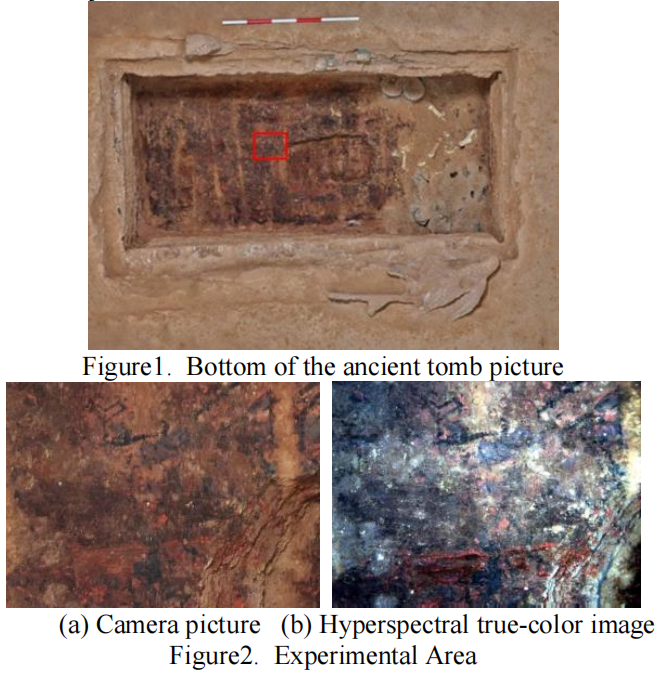
From Sanxingdui to Shanxi Ancient Tombs: Innovative Applications of Hyperspectral Imaging in Cultural Relics Archaeology
三星堆遺址的考古發現持續為我們揭示古蜀文明的奧秘,而支撐這些發現背后的,是一項正在革新考古學研究方法的技術——高光譜成像。在最近的三星堆考古工作中,這項技術已成功應用于青銅器等珍貴文物的無損檢測,幫助研究人員發現了許多被時間掩埋的歷史細節。
高光譜成像技術通過采集數百個連續波段的光譜信息,實現文物"圖譜合一"的精準檢測,既能記錄空間形態,又能分析物質組成,為考古研究提供多維數據支撐。本文以兩個案例為切入點,闡述高光譜成像技術在文物考古領域的創新應用。
The archaeological discoveries at the Sanxingdui site continue to unveil the mysteries of the ancient Shu civilization, supported by a technology revolutionizing archaeological research methods—hyperspectral imaging. In recent Sanxingdui excavations, this technology has been successfully applied to non-destructive testing of precious artifacts such as bronze ware and ivory, helping researchers uncover historical details long buried by time.
Hyperspectral imaging captures spectral information across hundreds of continuous bands, enabling precise "image-spectrum integration" detection of cultural relics. It records spatial morphology while analyzing material composition, providing multidimensional data support for archaeological research. This article explores two case studies to illustrate the innovative applications of hyperspectral imaging in cultural relics archaeology.

三星堆文物,圖片來源網絡 / Sanxingdui artifacts, image source: internet
「三星堆:探尋古蜀文明的奧秘」
「Sanxingdui: Unraveling the Mysteries of the Ancient Shu Civilization」
三星堆遺址作為20世紀最偉大的考古發現之一,其出土的青銅器等文物具有高歷史價值。然而,傳統分析方法如X射線熒光分析、電子探針等存在明顯局限:要么具有接觸破壞性,要么只能反映局部特征。中科院西安光機所聯合西北工業大學的研究團隊將高光譜成像技術應用于這一領域,實現了文物保護與研究的雙重突破。
As one of the greatest archaeological discoveries of the 20th century, the Sanxingdui site’s bronze ware, ivory, and other artifacts hold immense historical value. However, traditional analytical methods like X-ray fluorescence and electron microprobe have significant limitations—either being contact-destructive or only reflecting localized features. A research team from the Xi’an Institute of Optics and Precision Mechanics (Chinese Academy of Sciences) and Northwestern Polytechnical University applied hyperspectral imaging in this field, achieving breakthroughs in both cultural relic preservation and research.

遺址文物數據 / Archaeological site artifact data
該團隊構建了一套完整的高光譜文物分析技術體系,在多個關鍵環節實現創新突破。
在數據采集與處理環節,開發了基于相對坐標的區域拼接算法,通過精確計算重疊區域面積和多尺度特征匹配,大幅提升了多軌圖像拼接效率。該算法采用Dense SIFT算子進行快速特征提取,再通過RANSAC算法消除誤匹配點,實現無縫拼接。
在特征提取方面,創新性地將空間注意力機制引入HRNet網絡架構,通過特征圖分解和ResNet結構聚合,顯著提升了高分辨率圖像的空間定位精度。同時構建了金字塔3D殘差網絡,采用漸進式特征維度增長策略,實現了對812個波段光譜特征的深度解析。
該技術在實際應用中展現出優秀的性能,已成功處理821幀不同分辨率的高光譜圖像。通過對比實驗,最終采用視覺映射模型的數據-決策級融合方案,使青銅器等目標的平均識別準確率達到0.84,ROC曲線分析顯示AUC值較傳統方法提升15%以上。
The team developed a comprehensive hyperspectral analysis system for cultural relics, making innovative advances in multiple key areas.
In data acquisition and processing, they created a region-stitching algorithm based on relative coordinates, significantly improving multi-track image stitching efficiency through precise overlap area calculation and multi-scale feature matching. The algorithm employs the Dense SIFT operator for rapid feature extraction, followed by the RANSAC algorithm to eliminate mismatched points, achieving seamless stitching.
For feature extraction, they innovatively integrated a spatial attention mechanism into the HRNet architecture, enhancing spatial localization accuracy in high-resolution images through feature map decomposition and ResNet-based aggregation. They also constructed a pyramid 3D residual network, adopting a progressive feature dimension growth strategy to enable in-depth analysis of spectral features across 812 bands.
This technology demonstrated exceptional performance in practical applications, successfully processing 821 frames of hyperspectral images at varying resolutions. Comparative experiments led to the adoption of a data-decision-level fusion scheme based on a visual mapping model, achieving an average recognition accuracy of 0.84 for targets like ivory and bronze ware. ROC curve analysis showed a 15%+ improvement in AUC values compared to traditional methods.

算法流程圖 / Algorithm Flowchart
「山西古墓:解讀地下的歷史篇章」
「Shanxi Ancient Tombs: Deciphering Buried Historical Narratives」
山西南部某古墓底部存在大量黑色殘留物,這些疑似古代文字或圖案的痕跡因年代久遠和環境侵蝕,肉眼已難以辨識。北京建筑大學與山西省考古研究所聯合團隊采用高光譜成像系統(波長范圍400-1000nm,光譜分辨率0.6nm)對這一考古難題展開研究。
The bottom of an ancient tomb in southern Shanxi contained numerous black residues—faint traces suspected to be ancient writing or patterns, rendered nearly invisible to the naked eye due to age and environmental erosion. A joint team from Beijing University of Civil Engineering and Architecture and the Shanxi Provincial Institute of Archaeology employed a hyperspectral imaging system (wavelength range: 400–1000 nm, spectral resolution: 0.6 nm) to study this archaeological challenge.

古墓底部的照片,及實驗區域的高光譜圖像 / Photos of the tomb floor and hyperspectral images of the experimental area
研究團隊開發了完整的高光譜分析流程:首先通過輻射校正公式轉換數據,有效消除了儀器噪聲和光照干擾;然后篩選950個有效波段,利用主成分分析(PCA)濃縮信息;創新提出兩個特征指數公式優化目標識別;最后運用多種形態學算法組合,生成15種處理方案,為考古人員提供了豐富的參考選擇。
從考古價值來看,研究提供的多版本形態學處理結果成功重建了古墓底部疑似文字的連貫圖案,這些圖案在傳統檢測手段下無法辨識。這一發現不僅為解讀該墓葬的文化內涵提供了全新實物證據,更展示了高光譜技術在非接觸考古檢測中的巨大潛力。
The team developed a complete hyperspectral analysis workflow: first converting data via radiometric correction formulas to eliminate instrument noise and lighting interference; then selecting 950 effective bands and condensing information using principal component analysis (PCA); innovatively proposing two feature index formulas to optimize target identification; and finally applying a combination of morphological algorithms to generate 15 processing schemes, providing archaeologists with rich reference options.
From an archaeological perspective, the multi-version morphological processing results successfully reconstructed coherent patterns of suspected writing on the tomb floor—patterns entirely undetectable using traditional methods. This discovery not only offers new physical evidence for interpreting the tomb’s cultural significance but also highlights the immense potential of hyperspectral technology in non-contact archaeological detection.

數據處理流程 / Data Processing Workflow

光譜曲線 / Spectral Curve
「結語 / Conclusion」
高光譜成像技術正在為文物考古提供了新的技術路徑,幫助我們揭開歷史塵封的面紗。這項技術不僅守護著文物安全,更讓千年文明得以延續傳承。
Hyperspectral imaging is forging a new technological path for cultural relics archaeology, helping lift the veil of history. This technology not only safeguards artifacts but also ensures the enduring legacy of millennia-old civilizations.
案例來源 / Source:
1. Qiu, S., Zhang, P., Tang, X., Zeng, Z., Zhang, M. et al. (2023). Sanxingdui Cultural Relics Recognition Algorithm Based on Hyperspectral Multi-Network Fusion. Computers, Materials & Continua, 77(3), 3783–3800.
2. Yang, X., Hou1, M., Lyu, S., Ma, S., Gao, Z., Bai, S., Gu, M., Liu, Y., & Hou, M. (2018). INFORMATION EXTRACTION IN TOMB PIT USING HYPERSPECTRAL DATA. ISPRS - International Archives of the Photogrammetry, Remote Sensing and Spatial Information Sciences, 2107-2111.
 客服熱線:400-688-7769
客服熱線:400-688-7769 郵箱:market@exponentsci.com
郵箱:market@exponentsci.com 固話:020-89858550
固話:020-89858550 地址:廣州市天河區廣汕二路602號惠誠大廈B座403房
地址:廣州市天河區廣汕二路602號惠誠大廈B座403房
掃一掃 微信咨詢
©2025 愛博能(廣州)科學技術有限公司 版權所有 備案號:粵ICP備20046466號 技術支持:化工儀器網 Sitemap.xml 總訪問量:92799 管理登陸